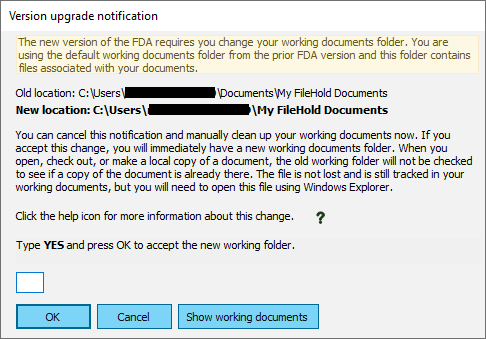Starting with FileHold version 17.1, the default location for working documents has changed. In prior versions this location was a sub-folder of your Windows Documents folder call My FileHold Documents. Customers always have the ability to change their working documents folder, but if this folder was left as the default, and you did not clean up your working documents before upgrading, the FDA will prompt you to change it to the new default.
For most users, you can simply confirm this change by typing the word YES (all capital letters) and pressing OK. If you are curious about what files are in your working documents, you can press Show working documents. If you are unsure what to do and press Cancel, you will be prompted with this notification the next time you start the FDA.

Version upgrade notification FAQ
Could have I avoided this message?
Yes. As a part of upgrade planning, all FileHold administrators are asked to ensure their users have cleaned their working documents from the default folder. In many cases, FileHold can clean working documents automatically but some situations require the user’s manual intervention.
How do I know my working documents are clean?
Choose Tools > Working Documents from the FDA menu to see your current working documents. Make sure the box is checked to show the working documents in the default folder. If there are no files in this list, your working documents are clean.
How do I know if I am using the default folder?
From the FDA menu, choose File > Preferences & Settings > User Preferences… and look to the bottom of the dialog under Default Local Working Folder. If the value is C:\Users\<my-user>\Documents\My FileHold Documents then you are using the old default folder and you will need to clean your files. In this case, <my-user> would be replaced by your actual user name or optionally your Windows domain and user name.
What happens if my working documents are clean before the upgrade?
When you are using the old default location for working documents and that location is clean, the FDA will automatically and silently change your working documents location to the new default location. The old folder will still exist on your drive in the Documents folder and you can delete it at your leisure.
What if I had changed my working document location to something other than the default?
In this case, nothing will change for you and you will not to clean anything before you upgrade. You will not get this notification.
What happens if I type YES and press OK without cleaning?
Nothing will be lost, but you may find some confusing situations. For example, if you opened a Word document to edit but left it in your working documents before upgrading, then opened it again after upgrading, instead of getting a warning that a newer version already exists the old version from FileHold would be opened and you might think your file was lost. However, it is not lost, it is just in the old working documents location and you will need to handle it manually.
What happens if I save documents to locations other than the default folder?
Depending on how your administrator has configured your system, some users may be able to choose any arbitrary location to save their files. These are also tracked in working documents, but because they are not in the default folder they are not affect by this change.
Why did FileHold change the default location?
Microsoft OneDrive synchronization does not interact well with the FileHold working documents as both systems are trying to keep the same files synchronized. This can cause conflicts and unexpected behaviour. For example, if the file is deleted in one system but not the other, a user might find that it magically reappears. In the early days of Microsoft OneDrive, users had to proactively enable and configure the service, but Microsoft has changed this model making OneDrive activity automatic and difficult to avoid. This includes automatically having it take over the Windows Document folder. FileHold made this change to avoid conflicts.
Can I still user the original default location? Yes
Yes, but we advise against this to avoid conflict with OneDrive and avoid the notification message that will appear every time you start the FDA.
